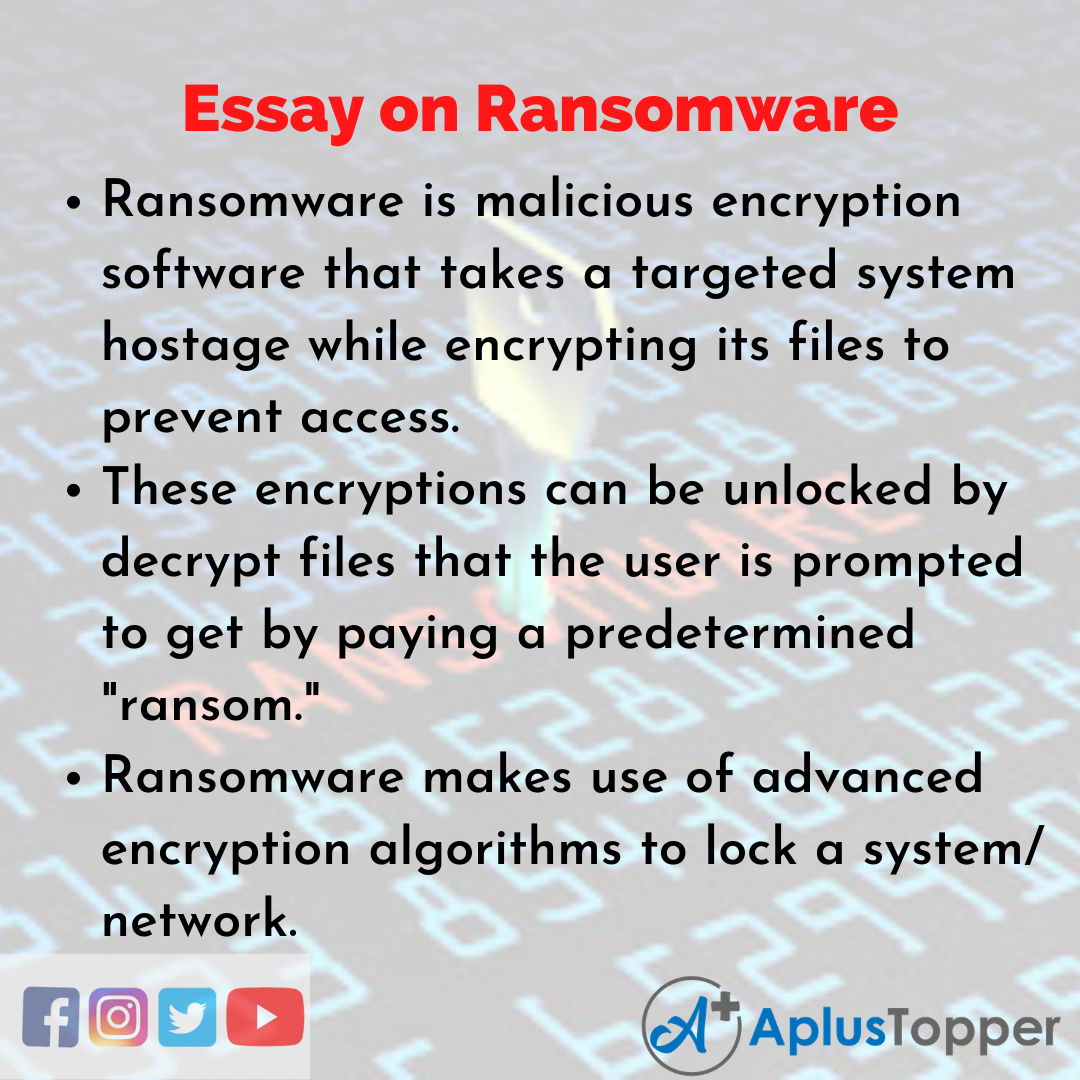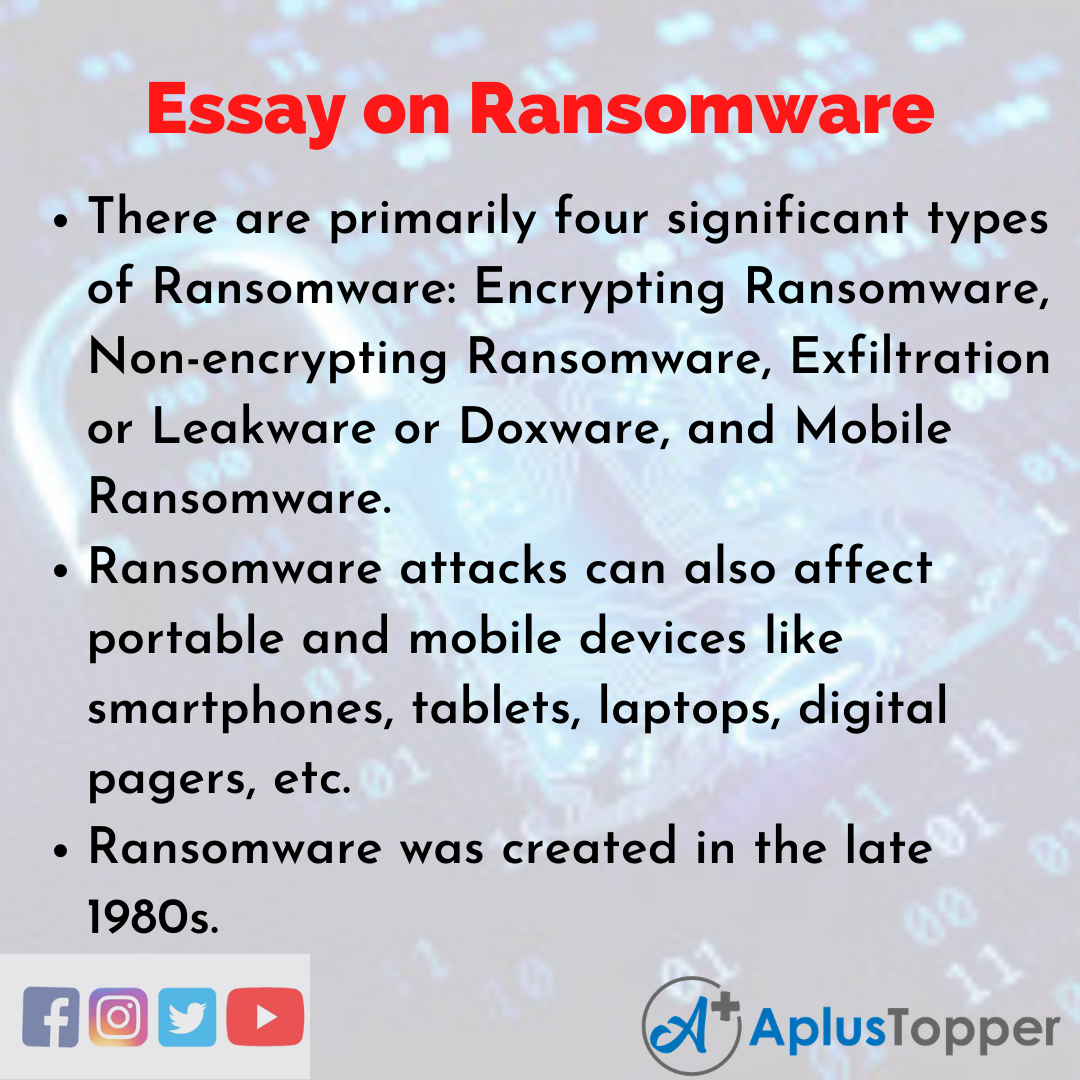Essay on Ransomware: Ransomware is the biggest cybersecurity threat organizations and individuals face in the digital world. It is a form of malicious software/ malware falling under crypto virology responsible for encrypting anything in a single PC up to a whole network, including complex servers.
A Ransomware eventually ends up threatening the victims of the affected digital properties to publish their data. Besides, it threatens to gradually block access to the said properties unless a specific “ransom” is paid.
You can also find more Essay Writing articles on events, persons, sports, technology and many more.
Long and Short Essays on Ransomware for Students and Kids in English
We provide students with essay samples on a long essay of 500 words and a short essay of 150 words on the topic Ransomware.
Long Essay on Ransomware 500 Words in English
Long Essay on Ransomware is usually given to classes 7, 8, 9, and 10.
Ransomware is malicious software that takes over a single or multiple PC/ PCs and large complex networks like servers and threatens to leak or erase the data present in them unless a certain ransom is paid to the perpetrators. It superficially prevents the digital property user from accessing the system or data by locking the display screen or using simple/ advanced encryption methods.
Although most Ransomware types are based on simple virtual encryption methodologies and can be unlocked by an expert, many of them deploy a technique called cryptoviral extortion that involves advanced encryption techniques and can only be decrypted upon paying the demanded ransom.
The ransoms are mostly transacted using digital currencies like Bitcoin, Lithium, Paysafecard, or even Credit cards, making tracing and prosecuting the involved violators difficult. The attacks are generally carried out using infected files like a Trojan disguised as an authorized and permissible file. The user is essentially tricked into downloading the file and opening it from the email attachment via which these files are usually sent. However, many types of Ransomware can travel between systems without the need for user authentication or interaction.
The earliest Ransomware was developed in the late 1980s, where the payments were generally asked via snail mail. Ransomware attacks have grown significantly since 2012. The year 2018 alone saw 181.5 million ransomware attacks in the first six months itself.
Ransomware attacks are generally delivered using malicious spam emails with attachments that are booby-trapped in PDFs and Word files. These files contain links to malicious web sources leading to the attack. Some attacks are also delivered as downloadable payloads carried by malicious pages, malware, mal-adverts, or exploit kits.
As the attack is executed on the targeted system, the malicious files lock the affected system screen. A crypto-ransomware further encrypts targeted files while a screen image/ notification gets displayed on the screen, preventing it from unlocking.
Modern Ransomware is categorized as crypto-ransomware, where the users/ victims can recover the affected system/ data with a decrypt key upon paying the ransom. The ransom prices vary based on the type of Ransomware attack complying with digital currencies’ exchange rates. Specific Ransomware attacks also demand the ransom via iTunes pay cards and Amazon gift cards.
Remember that paying the ransom doesn’t always guarantee access to the infected system or the detained data as the perpetrators mostly belong to criminal nature. Ransomware fall under the category of “scareware” in cybersecurity threats. It intimidates or scares the victim to pay a fee for recovering the affected system/ files.
There is no single defense or protection to stop Ransomware attacks, although users can take various multi-layered approaches to protect their systems from eventual attacks. Avoid visiting untrusted web sources or websites without using a VPN. Using proper cloud email-gateway security solutions can prevent malicious emails.
Short Essay on Ransomware 150 Words in English
Short Essay on Ransomware is usually given to classes 1, 2, 3, 4, 5, and 6.
The world of cyber threats is under continuous evolution, with Ransomware being on the top of the chain. Ransomware can take systems and files hostage, preventing access to the same by using malware/ malicious software delivered via emails and payload files attached to other malicious sources.
These attacks lock the affected system by displaying a notification message on the screen that prevents the user/ victim from unlocking the file. The victim is then intimidated into paying a “ransom” or fee to access the affected system and files.
Ransomware is under the crypto virology branch of cyber threats. They utilize complex encryption algorithms to infect and lock targeted systems and files while asking for a ransom to be paid in return. The payments are usually taken in digital currencies and online gift cards to avoid traceability, making it difficult to reach the perpetrators.
10 Lines on Ransomware Essay in English
1. Ransomware is malicious encryption software that takes a targeted system hostage while encrypting its files to prevent access.
2. These encryptions can be unlocked by decrypt files that the user is prompted to get by paying a predetermined “ransom.”
3. Ransomware was created in the late 1980s.
4. Ransomware makes use of advanced encryption algorithms to lock a system/ network.
5. There was a record of 181.5 million Ransomware attacks in the first six months of 2018 alone.
6. There are primarily four significant types of Ransomware: Encrypting Ransomware, Non-encrypting Ransomware, Exfiltration or Leakware or Doxware, and Mobile Ransomware.
7. Ransomware attacks can also affect portable and mobile devices like smartphones, tablets, laptops, digital pagers, etc.
8. The Ransom payment is generally processed using digital/ cryptocurrencies and online gift cards to avoid tracing.
9. Antivirus and Antimalware software major McAfee published data in June 2014, declaring that it had collected double the number of Ransomware samples that quarter than it did in the same quarter the previous year.
10. CryptoWall is the most massive known Ransomware that is estimated to have collected over $18 million US dollars in ransom fees by 2015.
FAQ’s on Ransomware Essay
Question 1.
How does a Ransomware attack happen?
Answer:
Ransomware attacks are generally deployed in the form of malicious links embedded in standard file formats like PDFs and Word documents delivered to the targeted systems/ networks via malicious emails and downloadable payloads integrated with another web source/ file.
Question 2.
What happens in the aftermath of a Ransomware attack?
Answer:
The affected system/ network is locked while its files are taken hostage by implementing simple/ advanced encryptions. The victim is then prompted to pay a ransom to regain access to the system and its files.
Question 3.
How can we prevent a Ransomware attack?
Answer:
Such attacks can be prevented via multiple steps like installing proper antimalware software in the system, using cloud email gateways with robust security measures, and using internet VPNs to mask the network IP while visiting suspicious/ untrusted websites.


